by Sharon Connell, Rosie Shepley, Olivia Weekes.
This article will outline steps taken by University of Leeds Special Collections to assess the condition of animation artworks in the Leeds Animation Workshop archive and develop long-term preservation and storage solutions.
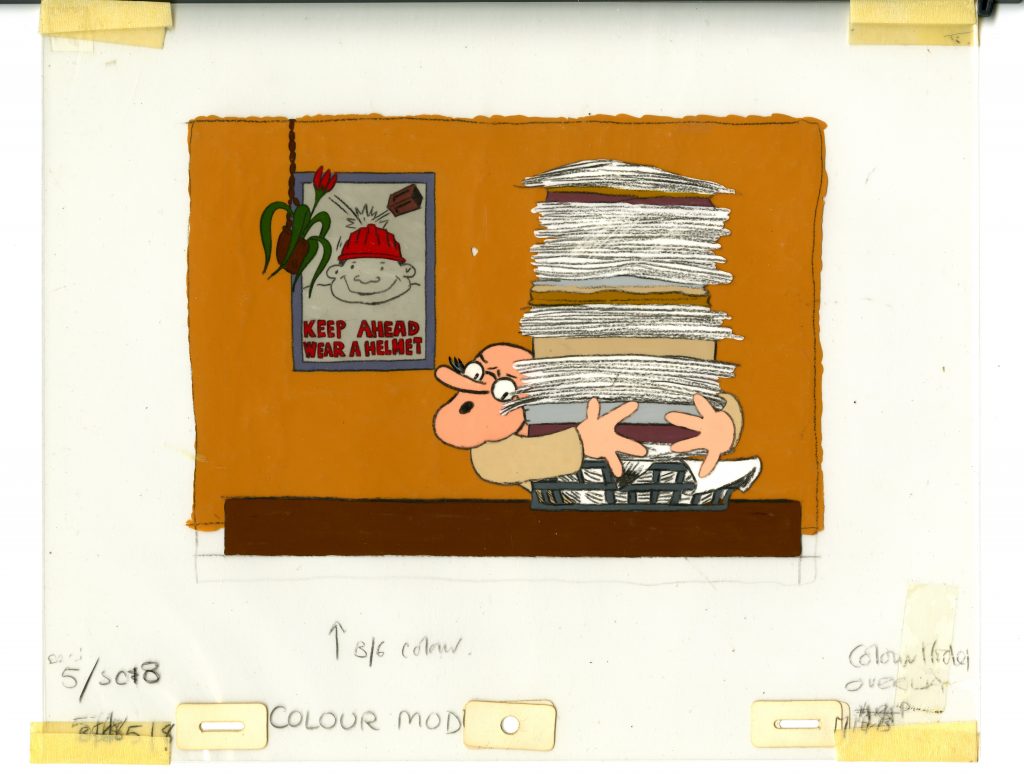
The Leeds Animation Workshop Archive
Leeds Animation Workshop (LAW) is a women’s collective set up in 1978 to produce and distribute animated films on social issues. LAW has produced over 40 animated films so far. Films have been distributed internationally, and the Workshop was recently the subject of a major exhibition at Palau de La Virreina in Barcelona. The LAW archive is the only complete archive of a collective independent filmmaking organisation in the UK. The archive includes all paper records of the Workshop and a large number of cel and paper animation artworks. This type of material was never created to last, some animation studios even scraped or washed and reused their cels for use in later films (Witowski, 1994). Luckily, LAW did not take this approach and a large amount of their animation artworks still survive. The artworks demonstrate the range techniques and styles used by LAW since their earliest days and are a rich resource for the study of traditional and less traditional animation styles. Taken together, the paper records and animation artworks form a rare complete record of a production from funding to research, production, and distribution. LAW agreed to donate their archive to Special Collections at the University of Leeds in December 2021. We were lucky to receive a grant from the Wellcome Trust to fund work on the collection. Work began in earnest with the appointment of a project archivist in July 2022. Although Special Collections regularly acquires new material, this would be the first time we had added animation artworks to our collections. We have robust procedures for preventive conservation, repackaging, cataloguing and digitising documents and books. This project gave us the opportunity to develop similar procedures for animation artworks. The Special Collections conservation team undertook several activities to develop a plan for treating the materials. A key part of this process was a practical knowledge-sharing workshop conducted by specialist conservators Carien van Aubel and Maartje Schalkx in Leeds. This focused on materials and techniques for storing animation cels and artworks. This training informed our approach to packaging, enabling us to create handling and packaging guidance for staff and volunteers.
Appraisal, Transfer and Quarantine
Project work began in earnest in summer 2022 when the paper records and animation materials created by LAW were appraised on site in the offices of the Workshop, in Harehills, Leeds by project staff. An initial survey estimated that there were over 6,000 unique animation artworks held at the site offices. Since we were not able to take every single item, the project archivist developed an Animation Artwork specific appraisal policy which enabled us to select material to add to the Archive. As a result, the archive includes around 2,000 cels and paper artworks. When new materials are added to our collections it is important that they be assessed, quarantined to monitor for pest, mould, or other issues they may introduce to the stores, and treated if necessary. To mitigate the risk of pest infestation, all the paper-based material in the LAW archive was sent for low temperature treatment before arriving at Special Collections. Cel artworks were unsuitable for this treatment due to their composite nature. They are made up of layers of varying materials including plastics, various media, and adhesives, which would physically respond differently when frozen, expanding and contracting unevenly. Freezing these items would have risked causing or exacerbating some of the condition problems already present such as flaking media layers. It was decided to treat these with anoxic treatment (see figure 1). This works by placing the objects in a sealed environment and depleting the oxygen to a level that kills the insect pest at all stages of their lifecycle. One method of doing this is to introduce oxygen scavengers into the sealed unit. Tests show that lowering the oxygen to 0.5% for a period of 21 days can kill any pests present (Child, 2002). After the material was treated and deemed safe to be stored in the University archive stores, a survey was completed to help with planning repackaging work and to ascertain any conservation needs of the animation artworks.
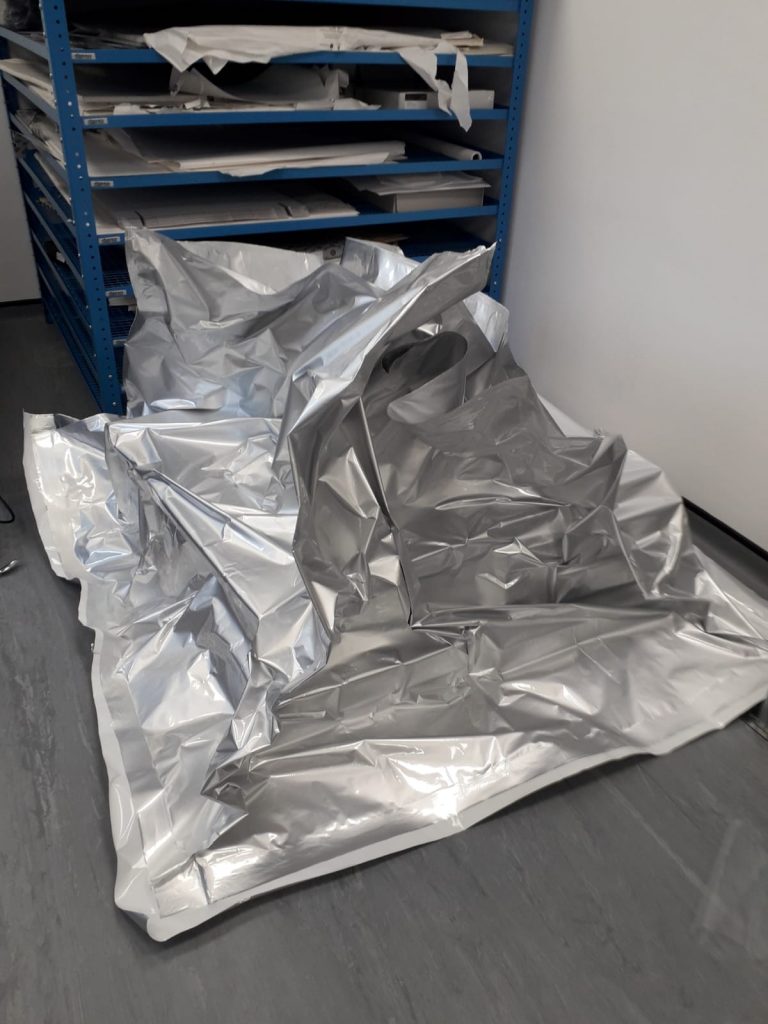
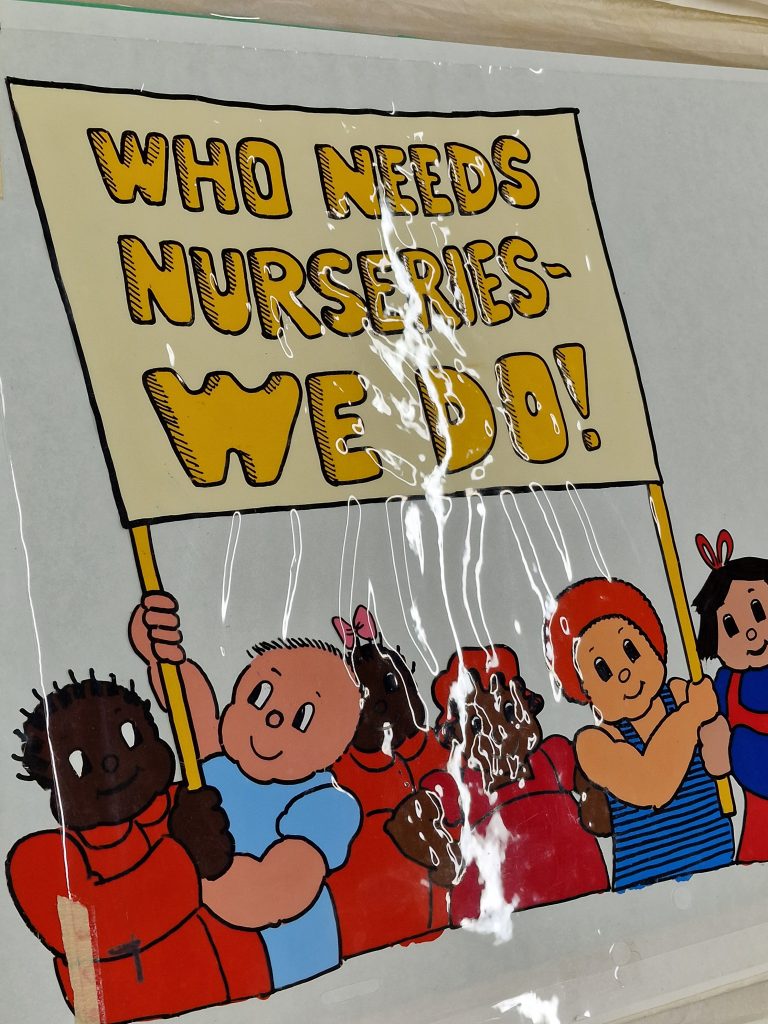

Assessment
Animation materials and artwork are at particular risk of degradation due to the unstable materials that they can be made from. They therefore require a careful and specific conservation approach to preserve them. A key deterioration mechanism, affecting the condition of animation cels is acetate deterioration, or ‘vinegar syndrome.’ As the cellulose acetate film base degrades, acetic acid is produced giving off the smell of vinegar. The presence of this acidity then chemically catalyses and accelerates the degradation of the materials. The structural stability of the cels can be compromised by this degradation. As the cellulose acetate degrades the material can also shrink, and warp, as well as discolour (Figure 1). The deterioration rate is linked to environmental conditions. This warped surface, along with flexing of the cels during handling and potentially poorly adhered paint layers can result in flaking and potential loss of vulnerable paint and media layers. Cels therefore need to be stored carefully in a temperature and humidity-controlled environment, appropriate materials need to be used for housing, and handling guidelines need to be in place to preserve them for as long as possible.
The artworks are arranged by film title, and within the films there was sometimes a mix of paper-based artworks and cel artworks. Each format required a different packaging approach, and suitable materials would have to be organized before repackaging. The Library’s Conservation Officer developed a survey spreadsheet to capture information about quantities and condition of all the different formats and materials in the archive to help us prepare. The following issues requiring attention were recorded where present for each item:
- torn paper
- creased paper
- torn cellulose acetate
- flaking/friable media
- cel warping
- embrittlement
- rusty paper clips
- loose cut-outs in box
- sticky
- disassociated item
- creased cellulose acetate
- folded cels
- vinegar smell
- air bubbles between the paint and the surface of the acetate (see figure 3)
Cel degradation, repackaging, and storage
Unfortunately, embrittlement and vinegar syndrome cannot be stopped as degradation of the cellulose acetate is something that can only be managed (Giachet et al, 2014). To preserve the LAW cels for as long as possible it was decided to separate the cels from the rest of the animation artworks and collection. This is due partly to the preservation requirements of the cels themselves, but also to reduce the risk of acetic acid off-gassing from the cels accelerating the degradation of the surrounding paper-based items. In addition, ongoing monitoring to measure and detect the severity of vinegar syndrome in the animation cels will be implemented, using A-D Strips, which change colour in response to different concentrations of acetic acid. The cels’ response to humidity and temperature changes creates the potential for physical stresses on these composite objects. As a precaution, it was decided that before moving cels from one area to another to check the temperature and RH, if there is more than 10% RH or 4°C difference then the cels should be left in their box for 24 hours to acclimatise. The cels are stored in shallow Microchamber board trays to help to adsorb and trap the acetic acid. This also limits the physical damage caused by stacking too many cels on top of each other, as the shallow trays can be stacked within boxes, maximising the amount of cels which can be stored safely within a single box. Microchamber spacers can also be made to fit within the boxes to trap the off-gassed acetic acid.
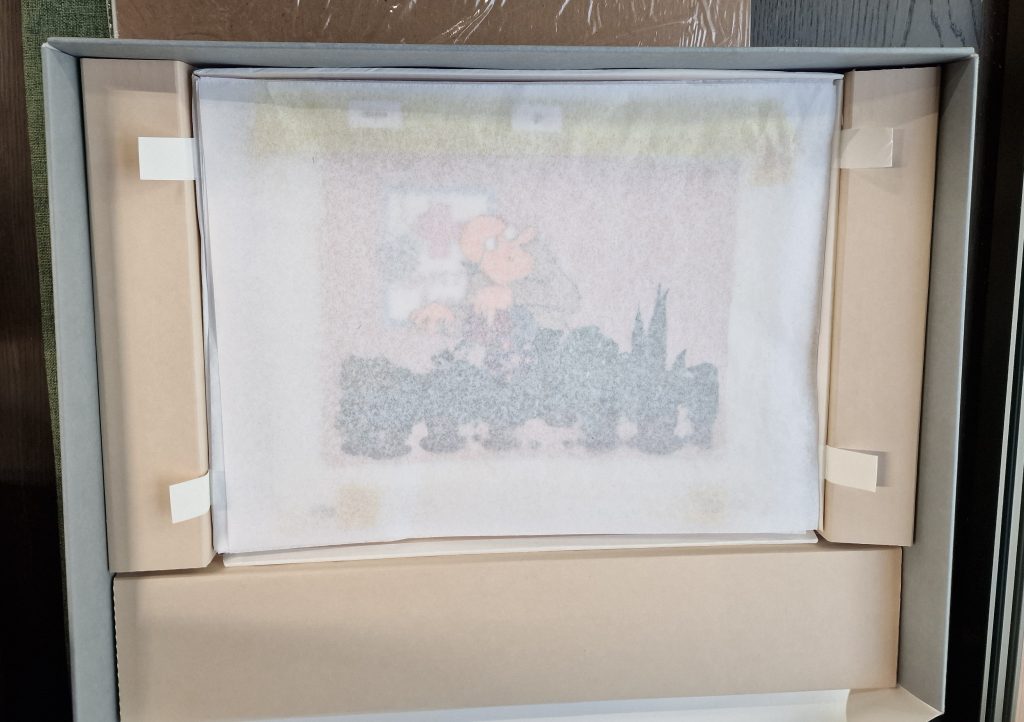
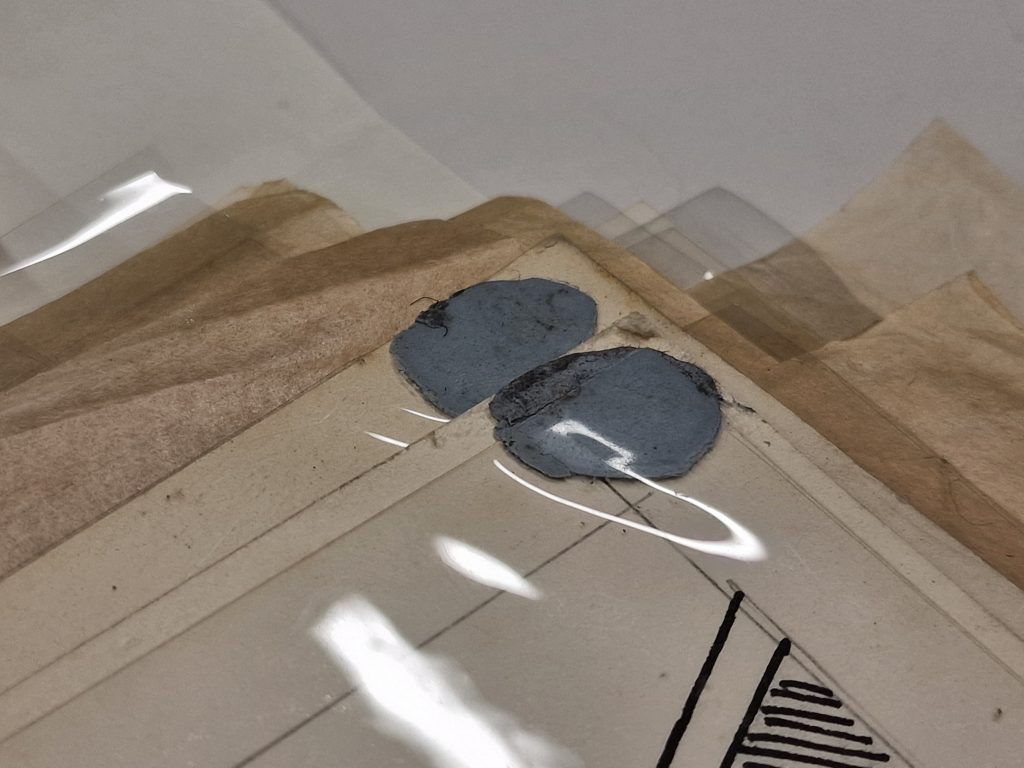
Volunteer Project
We were able to scan, describe and repackage all animation artworks in the collection with the help of a team of volunteers. Volunteers working on this project had previous conservation experience and were trained to undertake basic remedial action during the repackaging process. For example, some of the cels and paper cut outs in the LAW archive have several types of pressure sensitive tape (Sellotape, masking tape etc.) and putty adhesives on them (see figure 4). It was decided that these materials may be of interest to researchers as they show how the animation materials were used, therefore they would not be removed from the artworks. The volunteers were responsible for any basic work required to remediate this. For example, where sticky adhesive posed a risk to adjacent materials, the volunteers applied cellulose powder to prevent adhesion. Small pieces of Melinex were also used to stabilise sticky or oily adhesives. The volunteers also interleaved cels between sheets of unbuffered, acid free tissue paper to reduce the risk of a microclimate of acidity forming between the layers and aid handling. Acid free glassine paper interleaf was used where the cel layers had stuck together.
Handling, use and ongoing requirements
Handling guidelines have been written to inform staff and researchers how to handle the cels in the correct way. This includes using nitrile gloves, using a Silversafe paper folder to flip the cel over if the back needs to be studied and keeping the cel as flat as possible when lifting. The tissue paper interleaf was cut slightly bigger than the cels, this was to improve ease of handling and protect the edges of the cels from butting up against the sides of the storage tray. The researcher or staff picking up the individual cels can pick the cel up by gripping each side of the tissue paper, pulling slightly to ensure the cel remains flat and does not bend, which could cause flakes of paint to become loose and fall off the cel. As the volunteers are scanning the cels we now have a large collection of high-quality digital surrogates. These will be used in the first instance if the cel artworks are requested for research. This is to reduce handling and bending of the cel to prolong the life of the cel and ensure it stays stable for the longest period possible. The interleaf will then be visually inspected for signs of yellowing and pH tested on a regular basis to check for acidification. Interleaf and other housing materials should be replaced around every 5 years or when they start to show signs of chemical deterioration from their proximity to acidic animation cels.
Witkowski, L. 1994. “Animation Art: Its Production, Preparation for Sale, and Conservation.” In Walt Disney’s Snow White and the Seven Dwarfs: An Art in Its Making Featuring the Collection of Stephen H. Ison, edited by Martin F. Krause, 151–182. Indianapolis: Indianapolis Museum of Art; Hyperion.
Child, R.E., 2002. Anoxic Environments in Archive Conservation, Journal of the Society of Archivists, 23:2, 171-178, DOI: 10.1080/0037981022000006354
Giachet, M.T., Schilling, M., McCormick, K., Mazurek, J., Richardson, E., Khanjian, H. and Learner, T., 2014. Assessment of the composition and condition of animation cels made from cellulose acetate. Polymer degradation and stability, 107, pp.223-230. DOI: 10.1016/j.polymdegradstab.2014.03.009
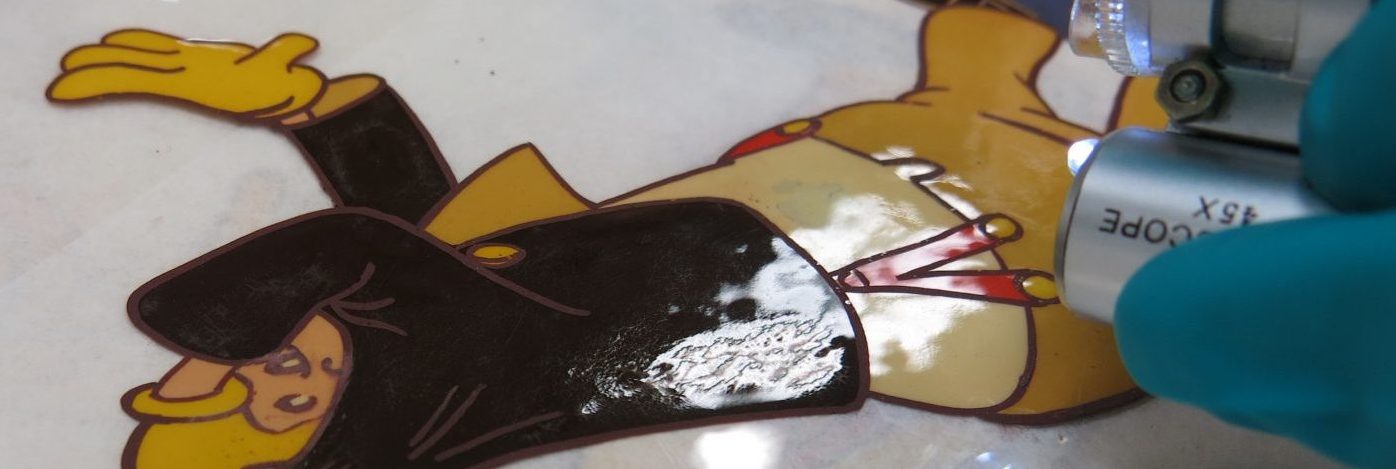
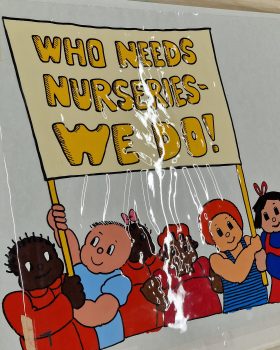
Spelling error report
The following text will be sent to our editors: